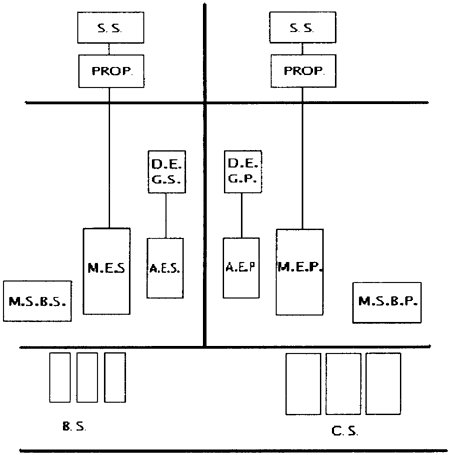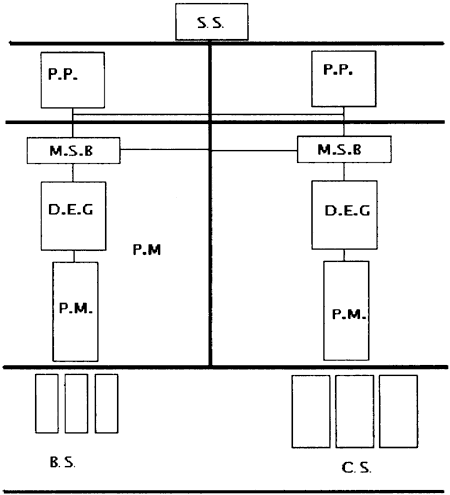- Use of all the systems that could be applicable for propulsion and steering;
- The propulsion should be considered as two-phase process. That means the phase for the surrounding water kinetic energy increasing and the phase for the directing of increased energy media in the direction opposite to the desired direction of navigation.
2. THE PROBLEM SOLUTION
According to the method Belak [1] the problem solution one begins with R2SA+ requirements analysis and afterwords with the synthesis of the prime solution.
2.1 The problem analysis
The R2SA+ requirements analysis gives the following requests that should be fulfilled by the design. The basic "Aframax tanker engine room and pump room outline design is shown in the Fig, 1 where is:
- M.E main engine,
- A.E auxiliary engine,
- D.E.G. diesel-electric generator,
- PROP. propeller,
- S.S. steering system,
- B.S. ballast system arrangement,
- C.S. cargo system arrangement;
and that is to be subjected to R2SA+ requirements as follows.
- The designed system consists of several main engines placed in separated spaces, and several propulsion systems.
- The designed system consists of several steering systems placed in separated spaces.
- The keeping of 50% reserve propulsion that can be established in 120 sec.
- Manouvreing and vessel position keeping during the 36 hours under previously defined conditions.
2.2 The prime solution synthesis
The prime solution shown in the Fig. 2 complies all the R2SA+ requests using the most simplified approach according Belak [1]

Fig. 2 The RS - 2 Compliant Tanker Engine Pump Room Outline Scheme
Where is:
- M.S.B.S/P main swichboard star/port,
- other marks as noted in the Fig. 1.
That means, that due to a single system element failure or a single space losing, the 50% (virtual) reserve propulsion and reserve (real) steering will be available. If one does not apply the additional requirements noted in Introduction, this design solution can be considered as the final solution.
If, however, the 50% reserve propulsion is analyzed considering the real navigation conditions, one can find that reserve unssufficient or less than 50% reserve. Keeping the main engine rate that enables 50% reserve propulsion, at the decreased speed of navigation, the propeller working conditions (the propeller working point) will cause the main engine overloading. That implies the necessity of CPP application, what causes that the propulsion efficiency will be decreased significantly. The solution of this problem, without CPP application, requires the rendundancy of each main engine.
The 50% reserve steering analysis shows, that the indepent steering systems application in separated spaces, mean that the reserve steering is higher than 50%. That is due to the actual possibility of steering using two propulsors at the different power consumption.
2.3 The further solutions synthesis
Possible solutions using the Method Belak [1] are shown in the Fig. 3 and Fig. 4.

Fig. 3 Energy Source Unification for Propulsion. Cargo and Balast System
Fig. 3 shows the possible unification of energy sources for propulsion, cargo and ballast system. The system prime movers are diesel engines driving the diesel-electro generators and main switchboards placed in separated spaces forming starboard and portside engine rooms connected through the switchboards. Propulsion devices are considered to be electro pumps arranged in special tubular propulsors aiming to decreasing the output water jet energy loss. The cargo system and the ballast system are separated but electro driven.
The reserve steering is obtained considering the single steering system and the auxiliary steering using the tubular arrangement of the propulsion.
BACK CONTENTS NEXT